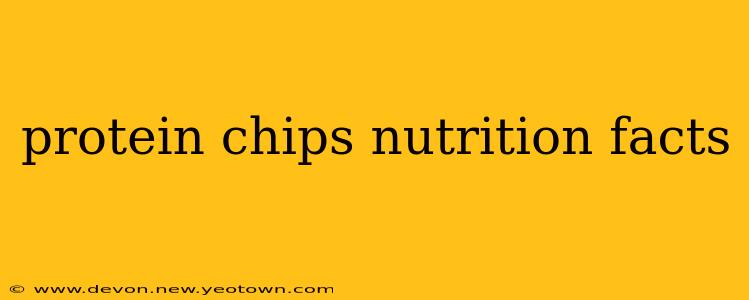Let's be honest, the allure of a crunchy, satisfying snack is hard to resist. But when it comes to choosing between potato chips and their protein-packed counterparts, the nutritional landscape shifts dramatically. This isn't just about calories; it's about understanding the complete nutritional profile and making informed choices for your health and wellness journey. This post dives deep into the world of protein chips, exploring their nutritional benefits, potential downsides, and answering your burning questions.
What are Protein Chips Made Of?
The beauty (and sometimes the beast) of protein chips lies in their ingredient diversity. Unlike traditional potato chips, protein chips can be crafted from a variety of sources, including lentils, chickpeas, soybeans, and even vegetables. Each base ingredient brings its unique nutritional fingerprint to the table. For example, lentil chips are often richer in fiber, while chickpea chips boast a higher protein content. The manufacturing process also plays a significant role; some brands utilize minimal processing, resulting in a more nutrient-dense product, while others may rely on more additives and processing methods that could affect the overall nutritional profile.
Are Protein Chips Healthy?
This isn't a simple yes or no answer. The healthiness of protein chips depends entirely on the specific brand and its ingredients. While many protein chips offer a higher protein content and a decent source of fiber compared to traditional potato chips, they can still be relatively high in calories and fat, especially if they’re heavily seasoned or fried. Reading the nutrition label carefully is crucial. Look for chips with lower sodium content, minimal added sugars, and a respectable amount of fiber.
How Many Calories are in Protein Chips?
Calorie count varies dramatically across brands and chip types. A typical serving (often around 1 ounce) can range from 100 to 150 calories or even more. The ingredients significantly impact the calorie count. Chips made with oil will naturally have a higher calorie content than those baked or air-popped. Always check the nutrition facts panel on the specific brand you’re considering.
What are the Benefits of Eating Protein Chips?
While they aren't a miracle food, protein chips can offer some definite advantages:
- Higher Protein Content: Compared to traditional potato chips, they offer a significant boost in protein, which is essential for building and repairing tissues, satiety, and overall muscle health.
- Fiber Rich: Many varieties are good sources of dietary fiber, contributing to digestive health and helping you feel fuller for longer.
- Nutrient-Dense (Depending on the Brand): Some brands incorporate vegetables or other nutrient-rich ingredients, adding vitamins and minerals to your snack.
Are Protein Chips Better Than Potato Chips?
Generally, yes. For those seeking a more nutrient-rich snack option, protein chips often offer a superior profile. However, this isn't a blanket statement. Some protein chips might be high in sodium or unhealthy fats, negating the benefits. Comparing nutrition labels side-by-side is essential before reaching for the bag.
What are the Downsides of Protein Chips?
While protein chips offer advantages, it's crucial to be aware of potential drawbacks:
- Sodium Content: Many brands are high in sodium, a concern for those watching their blood pressure.
- Added Sugars: Check for added sugars, which can negate some of the health benefits.
- Processing: While some are minimally processed, others may contain additives or undergo extensive processing.
How to Choose Healthy Protein Chips?
Choosing the right protein chips requires careful attention to the nutrition facts label. Prioritize brands that:
- Minimize added sugars and sodium.
- Have a high protein and fiber content.
- Emphasize whole-food ingredients (e.g., lentils, chickpeas).
- Are baked or air-popped rather than fried.
By understanding the nutritional nuances of protein chips and selecting wisely, you can enjoy a tasty and satisfying snack that aligns with your health goals. Remember, moderation is key, even with healthier snack options.

